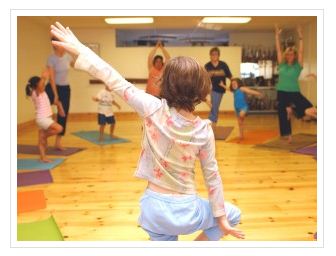OT Corner: Benefits of Yoga for Kids with Special Needs

by Sari Ockner, OTR/L
Occupational therapists help children with special needs build the underlying skills necessary to promote their success and independence in daily activities. This includes building their physical strength and endurance, while regulating their activity level, behavior, and emotions. Additionally, occupational therapy facilitates and feeds each child’s creativity and imagination.
Now lets talk yoga:
If you are a yoga enthusiast, such as myself, you can likely already imagine all the benefits of incorporating yoga into a child’s life. I have recently been trained and certified by Shana Meyerson, owner of mini yogis®, to teach yoga to children. I have started to incorporate yoga activities within my typical OT sessions, and WOW, not only do the children love it but I clearly see progress in each child with a few simple additions to what we were already doing.
Physical Benefits
Yoga promotes physical strength & muscular endurance, encouraging children to use all of their muscles. It helps to build balance, coordination, flexibility, and body awareness. Almost every position or asana incorporates the use of the core muscles, which ultimately promotes better posture. Yoga also teaches a child how to feel their breath and how the breathing physically impacts their bodies.
Motor Planning
Yoga positions incorporate using the body in different ways and across all planes of movement. Repetition, an important key in building new motor skills, is incorporated to help children master new movements. An important part of praxis or motor planning is coming up with novel ideas. Yoga encourages ideation skills and imagination, as children assist in picking different asanas and stringing together different sequences.
Emotional
Yoga can help to build a child’s self esteem, as no positions or ideas can be “wrong”. Unlike many physical activities, there is no winning or losing when practicing yoga. It is fun and playful!
Behavioral
So many of our children with special needs have difficulty regulating their arousal level, which leads to hyperactive and perceived aggressive behaviors. Yoga incorporates teaching breathing techniques and poses that require stillness. Yoga teaches a child to become more self aware of how their mind and body are connected and what it feels like to be still and calm.
Social
Yoga teaches individuals to be thankful, present, and kind to others. When building sequences children take turns and can build upon the ideas of others.
There are a variety of ways to work with children and incorporate yoga. Yoga with kids, especially younger ones, does not look like an adult class. It is all about incorporating a variety of fun tools to entice a child to be an active participant. Such components may include toys, games, songs, story books, or an obstacle course.
A session may start with sitting in a cross legged position and working on breathing, what a fabulous time to bring out whistles or bubbles to give that child sensory feedback on how their breath works! Maybe creating a sequence on how a tree grows (leading up to a one-legged tree asana) or how a super hero flies around the world to save his friends from trouble (flying on stomach with legs and arms raised high). A child’s yoga practice in this context is not “acting out” the actions but using yoga poses in a sequence to tell the story. Lastly, often the best part, shavasana. A time for stillness & teaching children an appreciation for quiet time, a skill necessary in school during teaching instruction or when going out in the community to places like a movie theater.
As the school year begins and parents are deciding which after school activities are best for their child, yoga is a fantastic option. Its fun, creative, and active!
PediaStaff is Hiring!
All JobsPediaStaff hires pediatric and school-based professionals nationwide for contract assignments of 2 to 12 months. We also help clinics, hospitals, schools, and home health agencies to find and hire these professionals directly. We work with Speech-Language Pathologists, Occupational and Physical Therapists, School Psychologists, and others in pediatric therapy and education.
